Crestone Peak applied to drill 216 wells in Boulder County
Judge dismisses Colorado Attorney General’s lawsuit v. Boulder County after moratorium expires on May 1
Local control is alive and well in Boulder County
By Bevo Beaven, Editor, Oil & Gas 360
A five year moratorium on drilling in unincorporated Boulder County, Colorado, just expired. Will oil and gas drilling return to Boulder County’s piece of the Wattenberg field, or is the political risk way too high? One Colorado oil and gas company is about to find out.
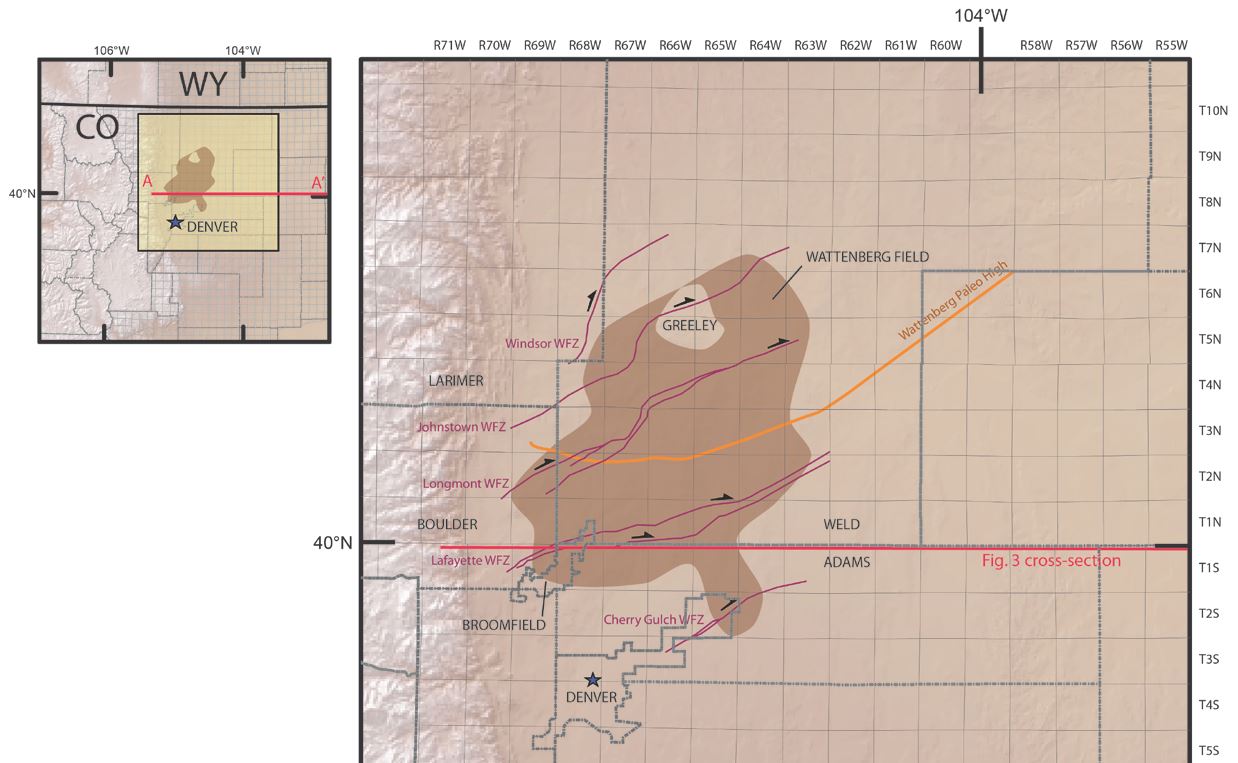
Boulder County borders the western edge of the prolific Wattenberg oil and gas field in northern Colorado, where many oil and gas companies are drilling and completing wells–companies like Anadarko Petroleum (ticker: APC), Noble Energy (ticker: NBL), Bill Barrett Corp. (ticker: BBG), PDC Energy (ticker: PDCE), SRC Energy (ticker: SRCI) Crestone Peak Resources, Great Western Oil & Gas and numerous others. Weld County is where the core Wattenberg has been staked by these and many other E&Ps.
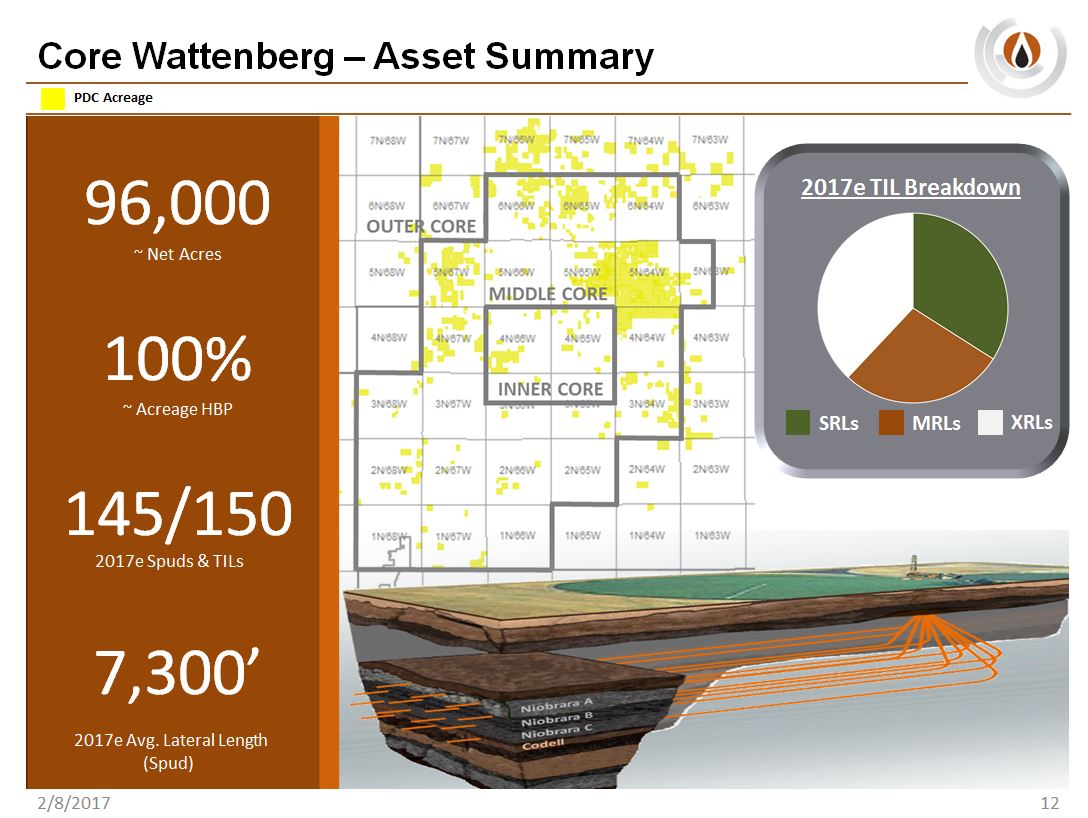
Weld County has seen many decades of financial prosperity, tax receipts and jobs from continuing oil and gas development in the Wattenberg field. In fact Weld brags it’s the only county in the U.S. with no county sales tax, thanks to its oil and gas tax revenues. But flush with technology companies (Google is building a regional headquarters in Boulder), the University of Colorado and more than its share of million-dollar home prices, Boulder County has shunned oil and gas development in recent years.
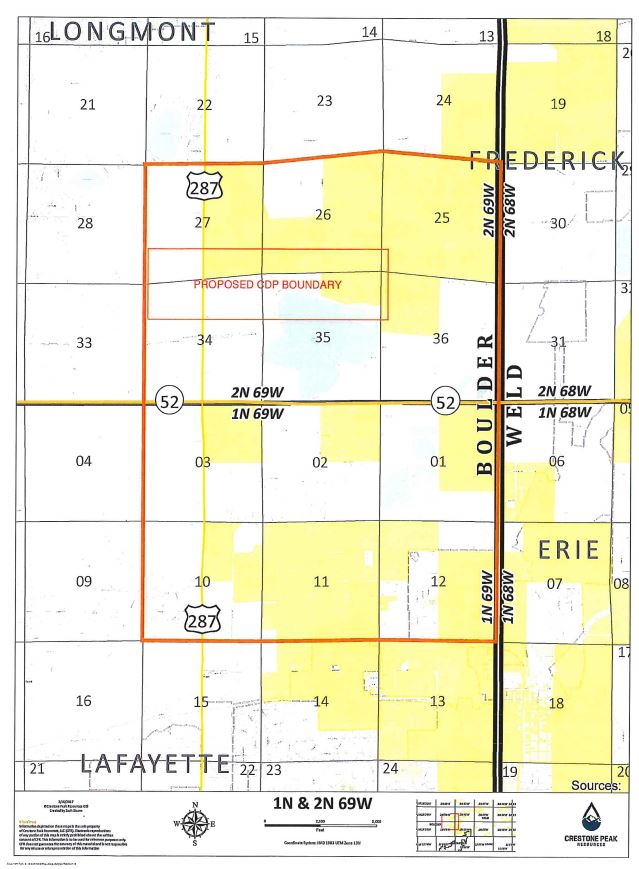
However, horizontal drilling and hydraulic fracturing of the Niobrara benches on the Boulder County side of the county line could prove to be economic, but are the rules too prohibitive for E&Ps to invest in Boulder County? Oil and gas-friendly Weld County’s next-door neighbor–which is home to the University of Colorado, environmental groups, community organizers, growth limits and climate action protesters–has demonstrated virtually zero enthusiasm for fossil fuel development inside its borders.
Colorado AG says ‘enough is enough’
On Jan. 26, 2017, Colorado Attorney General Cynthia Coffman released a statement entitled: “AG Coffman Sends Letter to Boulder County Commissioners Regarding Illegal Oil and Gas Restrictions.”
On Valentine’s Day, 2017, Coffman had had enough, and her office released the following statement announcing her office’s suit against Boulder County:

“Five years ago, in February of 2012, the Boulder County Board of County Commissioners imposed a moratorium on all new applications for oil or gas development in Boulder County. The Boulder Commissioners since have re-imposed or extended the moratorium eight separate times. Two of those extensions were passed after the Colorado Supreme Court ruled in May 2016 that local bans on oil or gas development are preempted if they conflict with the Colorado Oil and Gas Conservation Act, which regulates all aspects of oil and gas development and operations within the State.
“After the Supreme Court’s ruling in the City of Longmont and City of Fort Collins cases, other local governments acted to lift similar bans – except for Boulder County. On January 27, 2016, the Attorney General’s Office put Boulder County on notice that if it did not come into compliance with the law by February 10th, the State would take legal action against the County.
“The Boulder County Commissioners responded that they needed yet more time to draft regulations and prepare to accept new applications for oil or gas development. Because five years is more than reasonable time to complete such a project, and because Boulder County continues to operate in clear violation of Colorado law, the Attorney General today is filing suit in Boulder County District Court to compel compliance.
“It is not the job of industry to enforce Colorado law; that is the role of the Attorney General on behalf of the People of Colorado. Regrettably, Boulder County’s open defiance of State law has made legal action the final recourse available to the State.”
The Boulder County website reports that the “Boulder County Commissioners pledge to continue to protect public health, safety, and the environment from local oil & gas development,” in a press release issued April 25, 2017. The commission said, “In order to maximize the use of its limited local authority in other areas, Boulder County is committed to undertaking a series of legislative, legal, environmental, and public health “fixes” to help minimize the impacts of fracking on people and the environment.”
Boulder County is engaged in what it calls ‘oil and gas control’ – commissioners say they are working to protect the county from the impacts of oil and gas development
In its presentation, the commission refers to its efforts to engage in “oil and gas control.”
“Existing state law, solidified by decisions in 2016 by the Colorado Supreme Court, prohibits a ban or moratorium on permitting new oil and gas operations,” said County Commissioner Deb Gardner in a statement on April 25th.
“In fact, Boulder County is currently being sued by the state’s Attorney General’s Office for its temporary ban on new oil and gas applications that expires after May 1. That is why we are taking steps to use every tool available to us, short of an outright ban, to help us address the detrimental impacts to our air, water, and quality of life from oil and gas development in Boulder County.”

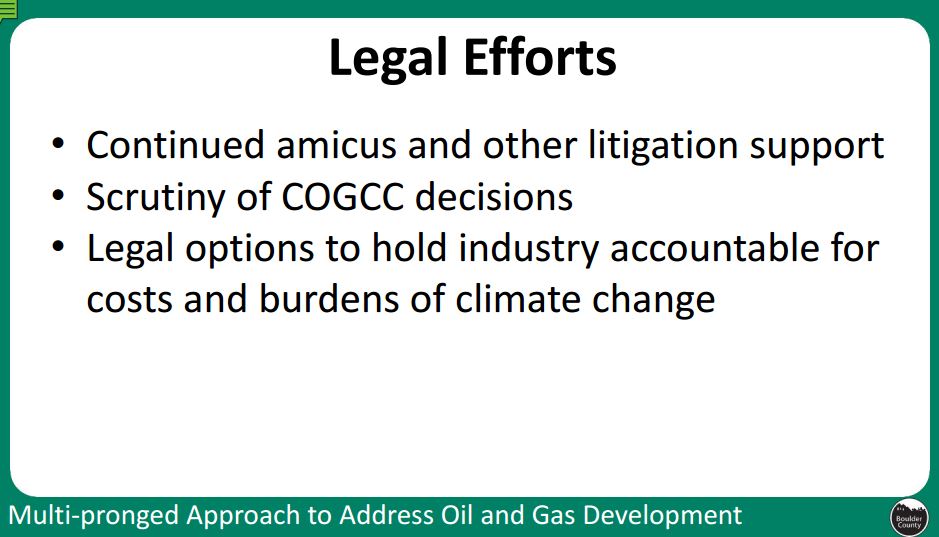
On May 1, 2017, Boulder County’s moratorium on accepting and processing new applications for oil and gas development in unincorporated parts of the county expired. The Boulder County Attorney’s office subsequently filed a motion to dismiss the complaints that the Attorney General’s office, the Colorado Oil and Gas Association and the American Petroleum Institute lodged in their challenge to the legality of the county’s moratorium, the Longmont Times-Call reported.
“The county’s real obstacle with state preemption challenges to local control is state statute, so we are encouraging our constituents to work with us to change state law,” said Commissioner Cindy Domenico in a statement. “While our current political climate doesn’t support this, sustained public advocacy directed at Colorado state rulemakers can, and hopefully will, change our political landscape to make it more favorable to local control and clean energy policy change. We must continue to pursue and advocate for better legislation on oil and gas, knowing that this is a multi-year strategy.”
“When May 1st comes, and our moratorium lapses, it doesn’t mean game over,” Commissioner Jones said. “It doesn’t mean that we’re giving up on local control, or that we’re saying yes to a tidal wave of new drilling. It doesn’t mean this fight is over by any stretch of the imagination. We are all in this together, sharing the common goal of working towards what’s best for Boulder County. As your Board of County Commissioners, we pledge to continue working to do all we can to protect this county and its residents from the impacts of oil and gas development and to forge a cleaner energy future for us all. … This isn’t a sprint, it’s a marathon.”
Test case: Crestone Peak’s application to drill 216 wells in east Boulder County
In its April presentation, Boulder County updates drilling application status from Crestone Peak Resources.
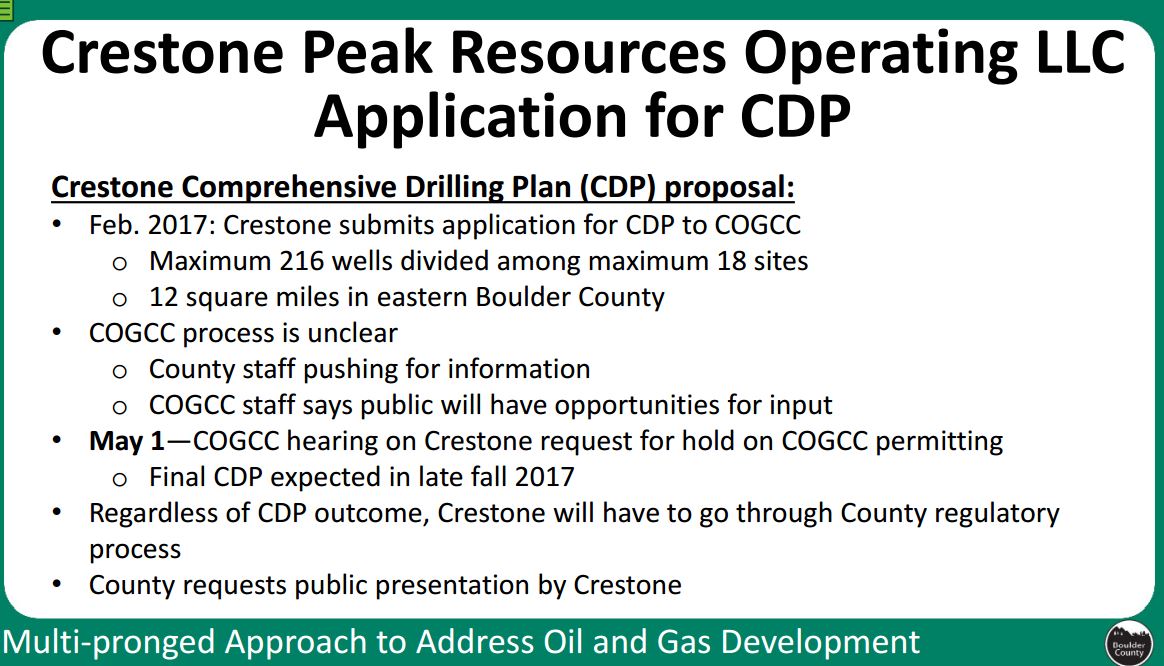
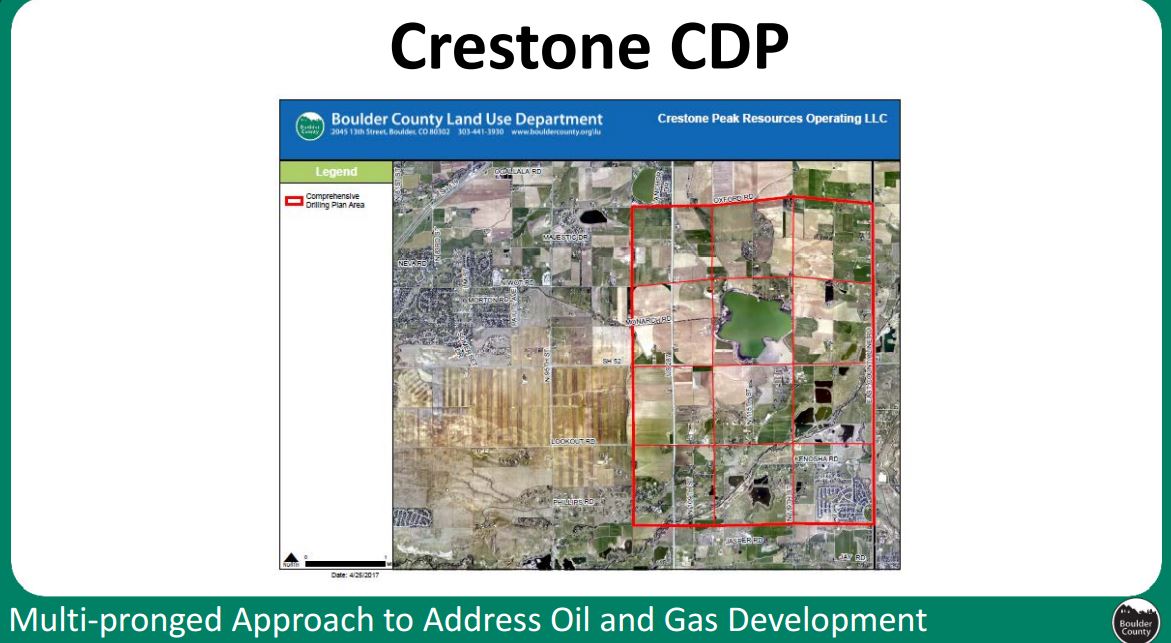
Local control is alive and well in Boulder County

After Boulder County let its moratorium on oil and gas development and hydraulic fracturing expire, Boulder District Court dismissed the Colorado attorney general’s lawsuit against Boulder County. Dismissal means that the issue of whether Boulder County had a right under state law to impose a moratorium won’t be decided for now, the Denver Business Journal reported. But what has happened is a clear movement toward local control of oil and gas permitting, regulation and development–which is the goal of numerous failed ballot issues that anti-oil and gas political forces have attempted to get onto the general election ballot several times during the past few years.
Boulder County said the moratorium was needed for it to complete preparation of new county Land Use Code regulations concerning oil and gas development, and about a month after the suit was filed by the Colorado AG, the Boulder County commissioners finally published their own oil and gas regulations.
The Boulder County Commission said, “These efforts are in addition to the regulations adopted by the Boulder County Commissioners last month that are considered to be the strongest set of local land use regulations on oil and gas development in the State of Colorado.”
“While my office will be watching how Boulder’s new rules are implemented, we have agreed to the dismissal of our court case since there no longer is a moratorium in place,” Coffman said.
Warning to Wattenberg drillers looking west: Boulder County says tread carefully, ‘COGCC approval is not Boulder County approval’
Boulder County’s oil and gas regulations comprise 50 pages and they are in the form of an “Application for Special Review.” Of note, the county makes it clear that anyone obtaining permits for oil and gas operations from the Colorado Oil and Gas Conservation Commission (COGCC)—the state agency that for decades has been charged with issuing drilling permits and strictly regulating oil and gas development—does not imply Boulder County approval.
A PDF file of the full rules document is available on the Boulder County website for download.
Requirements of oil and gas developers: Boulder County’s new rules
Excerpts from the Boulder County oil and gas regulations that were adopted by Boulder County commissioners on April 11, 2017, including air quality and land use conditions, are reproduced below:
Review and Community Engagement
- Special Review Required. Except as provided for in 12-300, all oil and gas operations on public and private land within the unincorporated areas of Boulder County must comply with this Article. Prior to the commencement of any oil and gas operations in the unincorporated County, an Applicant must submit a special review application and the Board must approve the application according to this Article. No other form of discretionary land use review under this Code is required for oil and gas operations covered by this Article 12. Special review approval is also required prior to the issuance of any County building permits, or associated pipeline, grading, access, floodplain, transportation impact fee, or other County permits necessary for the oil and gas operation. Oil and gas operations that may not require a building or other associated County permit must still obtain special review approval under this Article.
- Community Engagement. Boulder County requires Applicants to engage with local communities, residents, and other stakeholders prior to exploration or development activity. The purpose of this engagement is to provide sufficient opportunity for comment on plans; operations, and performance, to listen to concerns of the community, and to address all reasonable concerns as a result of a proposed operation.
- Surface Use Agreements. Oil and gas operators commonly enter into surface use agreements with landowners at or near the location of the development. The County recommends that surface agreements not be finalized until the Applicant has completed special review,at which time the impacts related to the proposed siting of the operation will be analyzed.
- APD approval. Application and Permit to Drill (“APD”) approval from the COGCC is not local approval, and compliance with all terms and conditions of special review approval is required in addition to the requirements of APD approval. The County strongly recommends that applicants apply to the County for special review prior to applying for APD so that the Applicant is aware of applicable County requirements and mitigation measures prior to filing its APD application.
Air Quality
Minimization of Hydrocarbon Emissions. To protect air quality, hydrocarbon emissions control measures may be required, including, but not limited to, one or more of the following:
- Electrification from the power grid or from renewable sources of all permanent operation equipment with engines or motors that can be electrified.
- Pipelines for water delivery to the site.
- Pipelines for transportation of oil and gas away from the site.
- Limitations on truck traffic to and from the site.
- Implementation of “tankless” production techniques.
- Environmentally sensitive and efficient production techniques,such as using naturalgas onsite rather than flaring.
- For well pads that are not electrically operated, use of quiet design mufflers (also referred to as hospital grade or dual dissipative) or equivalent.
- Use of acoustically insulated housing or covers to enclose the motor or engine.
- Manufacture test or other data demonstrating hydrocarbon destruction or control efficiency that complies with a design destruction efficiency of 98% or better.
- Bleed and vent restrictions on continuous bleed pneumatic devices, intermittent vent pneumatic devices, compressor engines, heater treaters, dehydrator reboilers,process heaters-pilot flames.
- Proof that any flare, auto ignition system, recorder, vapor recovery device or other equipment used to meet the hydrocarbon destruction or control efficiency requirement is installed, calibrated, operated, and maintained in accordance with the manufacturer’s recommendations, instructions, and operating manuals.
- Emissions controls of 90% or better for glycol dehydrators. m. Zero-emission desiccant dehydrators.
- Hydrocarbon control of 95% or better for crude oil, condensate, and produced water tanks with uncontrolled actual emissions of VOCs greater than five (5) TPY.
- Year-round application of odor requirements as set forth in 5 C.C.R. 1001-9, §XII (as amended).
- Electronic surveillance monitors to detect when pilot lights on control devices are extinguished.
- Drilling, completion and operation of wells using closed loop pitless systems for containment and/or recycling of all drilling, completion, flowback and produced fluids.
- Emission controls of hydrocarbon emissions of 95% or better for centrifugal compressors and reciprocating compressors.
- Dry seals on centrifugal compressors.
- Routing of emissions from rod-packing and other components on reciprocating compressors to vapor collection systems.
- Reduction or elimination of emissions of associated gas from hybrid gas-oil wells (i.e. gas that is co-produced from a well that primarily produces oil), Including prohibition of uncontrolled venting.
- Emission control of 90% or better during liquids unloading (i.e. maintenance activities to remove liquids from existing wells that are inhibiting production), including the installation of an automated plunger lift.
- Reduction or elimination of emissions from oil and gas pipeline maintenance activities such as pigging, including routing emissions to a vapor collection system.
- Proof of compliance with State-required dust control measures and imposition of an opacity requirement as tested using EPA Method 9.
- Odor reduction or elimination outside a specified distance from the well site.
- Use of an automated tank gauging system.
Land Disturbance and Compatibility
Conditions of approval that will reduce impacts to the site, natural resources, environmental resources, agricultural resources, floodways and floodplains, wetlands, and recreational activities, and will enhance compatibility with the surrounding area or scenic and rural character may be required, including, but not limited to, one or more of the following:
- Location. A change of the proposed location of the well pad that allows for extraction of the resource and mitigates the land use impacts.
- Reduction. A reduction of the number of wells on a single pad.
- Disruption. If occupants of residential structures within one (1) mile of a well or production facility site are significantly adversely affected by drilling and completion activities, reasonable disruption payments to those occupants. The presumptive amount of disruption payments shall be calculated as provided for in appendix 1, with reference to the expected time period from initiation of well construction through well completion and giving consideration to existing surface use agreements with such occupants. The presumptive disruption payments may be subject to changes based on special circumstances, such as the presence of home or land-based occupations, accommodations for occupants with special needs, loss of business income, and other factors affecting residen.ts. Any required disruption payments must be made at least sixty (60) days before commencement of well construction.
Table A: Rent Equivalencies
| Distance From
well (ft) |
House/Unit Size | ||||||
| Efficiency | 1Bedroom | 2 Bedroom | 3 Bedroom | 4 Bedroom | 5 Bedroom | 6bedroom | |
| 1-1320 | $905 | $1,021 | $1,240 | $1,763 | $2,065 | $2,374.75 | $2,684.50 |
| 1321 to 2640 | $452.50 | $510.50 | $620.00 | $881.50 | $1,032.50 | $1,187.38 | $1,342.25 |
| 2671 to 5280 | $90.5 | $102.1 | $124.0 | $176,3 | $206.5 | $237.5 | $268.5 |
Rents shown are for 2017
Rent Equivalencies for units/houses within 1 to 1320 feet of the well are valued at the Fair Market Rent as set by HUD for the year of disruption.
Distance from well is as defined in COGCC regulation 604(a) concerning Setbacks
Table B: Moving Equivalencies
| Distance From well |
Rate |
| 1-1320 | $2,300 |
| 1320 to 2640 | $1,150.0 |
| 2641 to 5280 | $230.0 |
Moving equivalencies shown above are for 2017. Each year starting in 2018 these rates shall be adjusted by the Consumer Price Index as set by the United States Department of labor,Bureau of labor Statistics for Denver-Boulder,all items,all urban consumers,or its successor index.
- Pad dimensions. Adjustment of pad dimensions to the minimum size necessary to accommodate operational needs while minimizing surface disturbance.
- Structures and surface equipment. Adjustment of structures and surface equipment to the minimal size necessary to satisfy operational needs.
- Shared infrastructure. Use of shared existing infrastructure by oil and gas operations, minimizing the installation of new facilities and avoiding additional disturbance to lands in a manner that reduces the introduction of significant new land use impacts to the environment, landowners and natural resources.
- Landscaping and irrigation. Landscaping plans including drought tolerant species that are native and less desirable to wildlife and suitable for the climate and soil conditions of the area. An irrigation plan may be required where buffering is accomplished with vegetation.
- Buffering of visual impacts. landscaping, berming, or other types of screening materials along the perimeter of the site between the surface equipment and surrounding areas.
- Vegetation. Maximization of the amount of natural screening available for the facility. Natural screening includes; but is not limited to, the use of existing vegetation as a background, the construction of the operation near screening stands of vegetation, or placement in valleys allowing topographic screening. Construction ofthe operation in a manner that minimizes the removal of and damage to existing trees and vegetation. If the operation requires clearing trees or vegetation, feathering and thinning of the edges of the cleared vegetation and mowing or br sh-hogging of the vegetation while leaving root structure intact, instead of scraping the surface.
- Equipment. Use of buried or low profile tanks and less intrusive equipment. Use of “quiet” drilling and completion equipment, such as the Quiet Fleet design provided by Liberty Oilfield Services.
- Remote monitoring and control. Use of Supervisory Control and Data Acquisition or other remote monitoring of wells, including remote telemetry units, onsite control valves, onsite data acquisition devices, and radio network/modems The ability to trigger an automatic shut-down of a facility for any reason at any time.
- Soils. Testing of soil samples to determine the extent of contamination from any spill or release,as well as to determine the adequacy of any remediation efforts.
- Spills and leaks. A leak detection plan to monitor for fluid leaks.
- Pipelines. A risk-based engineering study for proposed pipelines and modified construction, operation, or spacing standards that may exceed the minimum requirements in 12-700(5) for pipelines based on the outcome of the study.







